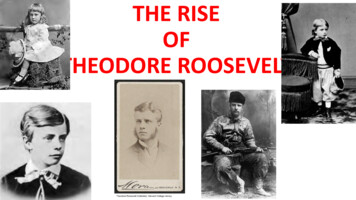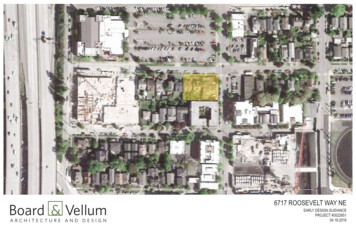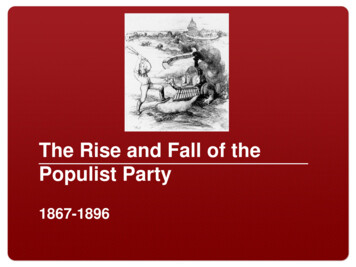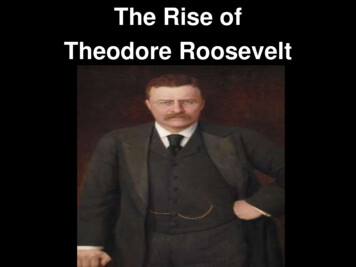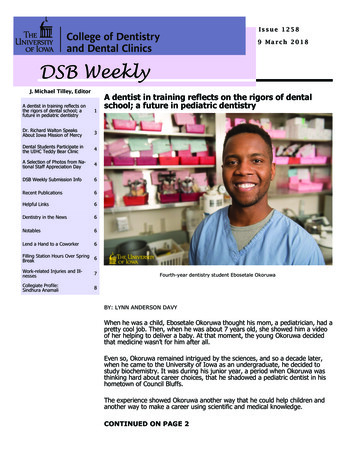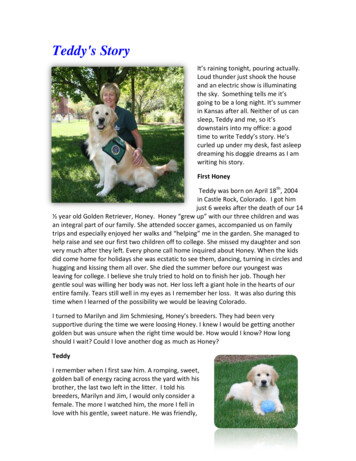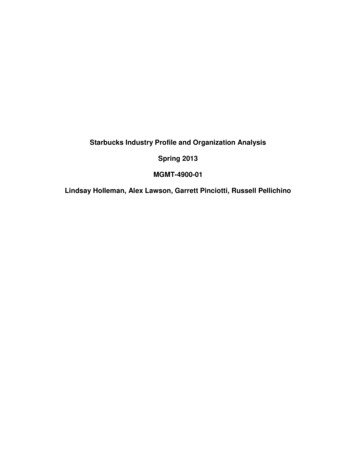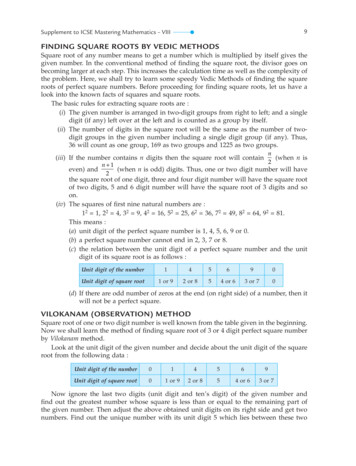
Transcription
10/17/028:54 AMPage 523Page 1 of 9Teddy Roosevelt’sSquare DealTerms & NamesWHY IT MATTERS NOWMAIN IDEAAs president, TheodoreRoosevelt worked to givecitizens a Square Dealthrough progressive reforms.As part of his Square Deal,Roosevelt’s conservationefforts made a permanentimpact on environmentalresources. Upton Sinclair The Jungle TheodoreRoosevelt Square Deal Meat InspectionAct Pure Foodand Drug Act conservation NAACPOne American's StoryWhen muckraking journalist Upton Sinclair began research fora novel in 1904, his focus was the human condition in the stockyards of Chicago. Sinclair intended his novel to reveal “thebreaking of human hearts by a system [that] exploits the labor ofmen and women for profits.” What most shocked readers inSinclair’s book The Jungle (1906), however, was the sickeningconditions of the meatpacking industry.A PERSONAL VOICE UPTON SINCLAIR“ There would be meat that had tumbled out on the floor, in thedirt and sawdust, where the workers had tramped and spituncounted billions of consumption [tuberculosis] germs. Therewould be meat stored in great piles in rooms; . . . and thousandsof rats would race about on it. . . . A man could run his hand overthese piles of meat and sweep off handfuls of the dried dung ofrats. These rats were nuisances, and the packers would put poisoned bread out for them; they would die, and then rats, bread,and meat would go into the hoppers together.”—The JunglePresident Theodore Roosevelt, like many other readers, was nauseated bySinclair’s account. The president invited the author to visit him at the WhiteHouse, where Roosevelt promised that “the specific evils you point out shall, iftheir existence be proved, and if I have the power, be eradicated.” p0523-531aspe-0517s3Upton Sinclairposes with hisson at the timeof the writing ofThe Jungle.A Rough-Riding PresidentTheodore Roosevelt was not supposed to be president. In 1900, the young governor from New York was urged to run as McKinley’s vice-president by the state’spolitical bosses, who found Roosevelt impossible to control. The plot to nominateRoosevelt worked, taking him out of state office. However, as vice-president,The Progressive Era523
p0523-531aspe-0517s310/17/028:54 AMPage 524Roosevelt stood a heartbeat away from becoming president. Indeed,President McKinley had served barely six months of his second term beforehe was assassinated, making Roosevelt the most powerful person in thegovernment. When thepresident spareda bear cub on ahunting expedition,a toymakermarketed apopular newproduct, theteddy bear. Teddy Rooseveltenjoyed an activelifestyle, as this1902 photoreveals.524ROOSEVELT’S RISE Theodore Roosevelt was born into a wealthy NewYork family in 1858. An asthma sufferer during his childhood, young Teddydrove himself to accomplish demanding physical feats. As a teenager,he mastered marksmanship and horseback riding. At Harvard College,Roosevelt boxed and wrestled.At an early age, the ambitious Roosevelt became a leader in NewYork politics. After serving three terms in the New York State Assembly,he became New York City’s police commissioner and then assistant secretary of the U.S. Navy. The aspiring politician grabbed national attention,advocating war against Spain in 1898. His volunteer cavalry brigade, the RoughRiders, won public acclaim for its role in the battle at San Juan Hill in Cuba.Roosevelt returned a hero and was soon elected governor of New York and thenlater won the vice-presidency.THE MODERN PRESIDENCY When Roosevelt was thrust into the presidency in1901, he became the youngest president ever at 42 years old. Unlike previouspresidents, Roosevelt soon dominated the news with his many exploits. While inoffice, Roosevelt enjoyed boxing, although one of his opponents blinded him inthe left eye. On another day, he galloped 100 miles on horseback, merely to provethe feat possible.In politics, as in sports, Roosevelt acted boldly, using his personality and popularity to advance his programs. His leadership and publicity campaigns helpedcreate the modern presidency, making him a model by which all future presidentswould be measured. Citing federal responsibility for the national welfare,Roosevelt thought the government should assume control whenever states provedincapable of dealing with problems. He explained, “It is the duty of the presidentto act upon the theory that he is the steward of the people, and . . . to assume thathe has the legal right to do whatever the needs of the people demand, unless theConstitution or the laws explicitly forbid him to do it.”Page 2 of 9
p0523-531aspe-0517s310/17/02MAIN IDEASynthesizingA What actionsand characteristicsof Teddy Rooseveltcontributed to hisreputation as thefirst modernpresident?BackgroundSee trust onpage R47 in theEconomicsHandbook.8:54 AMPage 525Page 3 of 9Roosevelt saw the presidency as a “bully pulpit,” from which he could influence the news media and shape legislation. If big business victimized workers,then President Roosevelt would see to it that the common people received whathe called a Square Deal. This term was used to describe the various progressivereforms sponsored by the Roosevelt administration. AUsing Federal PowerA. AnswerRoosevelt wasan active, forceful, and energetic executive;he used hisposition toshape legislation and influence the media.Roosevelt’s study of history—he published the first of his 44 books at the age of24—convinced him that modern America required a powerful federal government. “A simple and poor society can exist as a democracy on the basis of sheerindividualism,” Roosevelt declared, “but a rich and complex industrial societycannot so exist. . . .” The young president soon met several challenges to his assertion of federal power.TRUSTBUSTING By 1900, trusts—legal bodies created to hold stock in manycompanies—controlled about four-fifths of the industries in the United States.Some trusts, like Standard Oil, had earned poor reputations with the public by theuse of unfair business practices. Many trusts lowered their prices to drive competitors out of the market and then took advantage of the lack of competition tojack prices up even higher. Although Congress had passed the Sherman AntitrustAct in 1890, the act’s vague language made enforcement difficult. As a result,nearly all the suits filed against the trusts under the Sherman Act were ineffective.President Roosevelt did not believe that all trusts were harmful, but he soughtto curb the actions of those that hurt the public interest. The president concentrated his efforts on filing suits under the Sherman Antitrust Act. In 1902,Roosevelt made newspaper headlines as a trustbuster when he ordered the JusticeDepartment to sue the Northern Securities Company, which had established amonopoly over northwestern railroads. In 1904, the Supreme Court dissolved thecompany. Although the Roosevelt administration filed 44 antitrust suits, winninga number of them and breaking up some of the trusts, it was unable to slow themerger movement in business.Analyzing“THE LION-TAMER”As part of his Square Deal, President Roosevelt aggressivelyused the Sherman Antitrust Act of 1890 to attack big businessesengaging in unfair practices. His victory over his first target, theNorthern Securities Company, earned him a reputation as ahard-hitting trustbuster committed to protecting the public interest.This cartoon shows Roosevelt trying to tame the wild lions thatsymbolize the great and powerful companies of 1904.SKILLBUILDER Analyzing Political Cartoons1. What do the lions stand for?2. Why are all the lions coming out of a door labeled “Wall St.”?3. What do you think the cartoonist thinks about trustbusting? Citedetails from the cartoon that support your interpretation.SEE SKILLBUILDER HANDBOOK, PAGE R24.The Progressive Era525
p0523-531aspe-0517s3“10/17/028:54 AMPage 5261902 COAL STRIKE When 140,000 coal miners in Pennsylvania went on strikeand demanded a 20 percent raise, a nine-hour workday, and the right to organizea union, the mine operators refused to bargain. Five months into the strike, coalreserves ran low. Roosevelt, seeing the need to intervene, called both sides to theWhite House to talk, and eventually settled the strike. Irked by the “extraordinarystupidity and bad temper” of the mine operators, he later confessed that only thedignity of the presidency had kept him from taking one owner “by the seat of thebreeches” and tossing him out of the window.Faced with Roosevelt’s threat to take over the mines, the opposing sides finally agreed to submit their differences to an arbitration commission—a third partythat would work with both sides to mediate the dispute. In 1903, the commissionissued its compromise settlement. The miners won a 10 percent pay hike and ashorter, nine-hour workday. With this, however, they had to give up theirdemand for a closed shop—in which all workers must belong to the union—andtheir right to strike during the next three years.President Roosevelt’s actions had demonstrated a new principle.In life, as in aFrom then on, when a strike threatened the public welfare, the fedfootball game, the eral government was expected to intervene. In addition, Roosevelt’sprinciple . . . is:actions reflected the progressive belief that disputes could be settledHit the line hard.” in an orderly way with the help of experts, such as those on thearbitration commission. BTHEODORE ROOSEVELTRAILROAD REGULATION Roosevelt’s real goal was federal regulation. In 1887,Congress had passed the Interstate Commerce Act, which prohibited wealthy railroad owners from colluding to fix high prices by dividing the business in a givenarea. The Interstate Commerce Commission (ICC) was set up to enforce the newlaw but had little power. With Roosevelt’s urging, Congress passed the Elkins Actin 1903, which made it illegal for railroad officials to give, and shippers to receive,rebates for using particular railroads. The act also specifiedthat railroads could not change set rates without notifyingthe public.The Hepburn Act of 1906 strictly limited the distribution of free railroad passes, a common form of bribery. Italso gave the ICC power to set maximum railroad rates.MEAT INSPECTIONAlthough Roosevelt had to compromise with conservativeDuring the Progressive Era, peosenators who opposed the act, its passage boosted the govple worried about the kinds ofernment’s power to regulate the railroads.things that might fall—or walk—N OWTHENinto a batch of meat beingprocessed. Today, Americansworry more about contaminationby unseen dangers, such asE. coli bacteria, mad cow disease, and antibiotics or otherchemicals that may pose longrange health risks to people.In July 1996, Congress passedthe most extensive changes instandards for meat inspectionsince the Meat Inspection Act of1906. The costs of the new,more scientific inspectionsamount to about a tenth of apenny per pound of meat. TheFDA has also adopted restrictionson importation of feed and livestock from other countries to prevent the spread of disease.526CHAPTER 17Health and the EnvironmentPresident Roosevelt’s enthusiasm and his considerable skillat compromise led to laws and policies that benefited bothpublic health and the environment. He wrote, “We recognize and are bound to war against the evils of today. Theremedies are partly economic and partly spiritual, partly tobe obtained by laws, and in greater part to be obtained byindividual and associated effort.”REGULATING FOODS AND DRUGS After reading The Jungleby Upton Sinclair, Roosevelt responded to the public’s clamor for action. He appointed a commission of experts to investigate the meatpacking industry. The commission issued ascathing report backing up Sinclair’s account of the disgusting conditions in the industry. True to his word, in 1906Roosevelt pushed for passage of the Meat Inspection Act,Page 4 of 9B. Answer Fromthat point on,the federal government wasexpected to playa more activerole in settlinglabor disputes.MAIN IDEAAnalyzingEffectsB What wassignificant aboutthe way the 1902coal strike wassettled?Vocabularycollude: to acttogether secretlyto achieve anillegal or deceitfulpurpose
p0523-531aspe-0517s310/17/028:54 AMPage 527Page 5 of 9Coal Mining in the Early 1900sCoal played a key role in America’s industrial boom around the turn of the century,providing the United States with about 90 percent of its energy. Miners often hadto dig for coal hundreds of feet below the earth’s surface. The work in thesemines was among the hardest and most dangerous in the world. Progressive Erareforms helped improve conditions for miners, as many won wage increases andshorter work hours. The coal mines employedthousands of children, like thisboy pictured in 1909. In 1916,progressives helped securepassage of a child labor law thatforbade interstate commerce ofgoods produced by childrenunder the age of 14.Most underground mines hadtwo shafts—an elevator shaft(shown here) for transportingworkers and coal, and an airshaft for ventilation. pillarsThe miners’ maintool was the pick.Many also useddrilling machines.Donkeys or mules pulled thecoal cars to the elevators,which transported the coalto the surface.air shaftroomLike these menworking in 1908,miners typicallyspent their daysin dark, crampedspaces underground.elevatorshaftroomMost mines used a room-and-pillar method for extractingcoal. This entailed digging out “rooms” of coal off a seriesof tunnels, leaving enough coal behind to form a pillar thatprevented the room from collapsing.The Progressive Era527
p0523-531aspe-0517s310/17/028:54 AMPage 528Page 6 of 9 Governmentworkers inspectmeat as it movesthrough thepackinghouse.which dictated strict cleanliness requirements for meatpackers and created the program of federal meat inspection that was in use until it was replaced by moresophisticated techniques in the 1990s.The compromise that won the act’s passage, however, left the governmentpaying for the inspections and did not require companies to label their cannedgoods with date-of-processing information. The compromise also granted meatpackers the right to appeal negative decisions in court.A typical late19th-centuryproductadvertisement. PURE FOOD AND DRUG ACT Before any federal regulations were establishedfor advertising food and drugs, manufacturers had claimed that their productsaccomplished everything from curing cancer to growing hair. In addition, popular children’s medicines often contained opium, cocaine, or alcohol. In a series oflectures across the country, Dr. Harvey WashingtonWiley, chief chemist at the Department of Agriculture,criticized manufacturers for adding harmful preservatives to food and brought needed attention to this issue.In 1906, Congress passed the Pure Food andDrug Act, which halted the sale of contaminatedfoods and medicines and called for truth in labeling.Although this act did not ban harmful products outright, its requirement of truthful labels reflected theprogressive belief that given accurate information, people would act wisely. CCONSERVATION AND NATURAL RESOURCESBefore Roosevelt’s presidency, the federal governmenthad paid very little attention to the nation’s naturalresources. Despite the establishment of the U.S. ForestBureau in 1887 and the subsequent withdrawal frompublic sale of 45 million acres of timberlands for anational forest reserve, the government stood by whileprivate interests gobbled up the shrinking wilderness.528CHAPTER 17MAIN IDEAComparingC Whatsimilarities did theMeat InspectionAct and Pure Foodand Drug Actshare?C. Answer Bothacts createdregulations thatprotected consumers’ health.
p0523-531aspe-0517s310/17/028:54 AMPage 529Page 7 of 9In the late 19th century Americans had shortsightedly exploited their natural environment. Pioneer farmers leveled the forests and plowed up the prairies.Ranchers allowed their cattle to overgraze the Great Plains. Coal companies cluttered the land with refuse from mines. Lumber companies ignored the effect oftheir logging operations on flood control and neglected to plant trees to replacethose they had cut down. Cities dumped untreated sewage and industrial wastesinto rivers, poisoning the streams and creating health hazards.SkillbuilderAnswers1. The West.2. Roosevelthelped establisha strong conservative movement in theUnited States.CONSERVATION MEASURES Roosevelt condemned the view that America’sresources were endless and made conservation a primary concern. John Muir, anaturalist and writer with whom Roosevelt camped in California’s YosemiteNational Park in 1903, persuaded the president to set aside 148 million acres offorest reserves. Roosevelt also set aside 1.5 million acres of water-power sites andanother 80 million acres of land that experts from the U.S. Geological Surveywould explore for mineral and water resources. Roosevelt also established morethan 50 wildlife sanctuaries and several national parks.True to the Progressive belief in using experts, in 1905 the president namedGifford Pinchot as head of the U.S. Forest Service. A professional conservationist,Pinchot had administrative skill as well as the latest scientific and technical information. He advised Roosevelt to conserve forest and grazing lands by keepinglarge tracts of federal land exempt from private sale.Conservationists like Roosevelt and Pinchot, however, did not share theviews of Muir, who advocated complete preservation of the wilderness. Instead,conservation to them meant that some wilderness areas would be preservedwhile others would be developed for the common good. Indeed, Roosevelt’s federal water projects transformed some dry wilderness areas to make agriculturepossible. Under the National Reclamation Act of 1902, known as the NewlandsFederal Conservation Lands, 1872–1996130 W40 N40 NNEWSFederal Conservation Lands30 NCreated 1909–1996Created 1901–1908Created 1872–190000160 W150 W140 W110 W90 W200200400 miles400 kilometers80 W70 WGEOGRAPHY SKILLBUILDER1. Region Prior to 1901, which regions had the20 Ngreatest amount of conservation lands?2. Human Enviroment Interaction Describethe effects of Roosevelt’s conservation effortsand the impact he had on the environment?The Progressive Era529
p0523-531aspe-0517s310/17/028:54 AMHISTORICALS P O TLIG H TPage 530Act, money from the sale of public lands in the West fundedlarge-scale irrigation projects, such as the Roosevelt Dam inArizona and the Shoshone Dam in Wyoming. The NewlandsAct established the precedent that the federal governmentwould manage the precious water resources of the West. DRoosevelt and Civil RightsRoosevelt’s concern for the land and its inhabitants was notmatched in the area of civil rights. Though Roosevelt's fatherhad supported the North, his mother, Martha, may wellhave been the model for the Southern belle Scarlet O’Hara inMargaret Mitchell's famous novel, Gone with the Wind. Inalmost two terms as president, Roosevelt—like most otherprogressives—failed to support civil rights for AfricanYOSEMITE NATIONAL PARKAmericans. He did, however, support a few individual AfricanThe naturalist John Muir visitedAmericans.the Yosemite region of centralCalifornia in 1868 and made itDespite opposition from whites, Roosevelt appointed anhis home base for a period of sixAfrican American as head of the Charleston, South Carolina,years while he traveled throughcustomhouse. In another instance, when some whites inout the West.Mississippi refused to accept the black postmistress he hadMuir was the first to suggestappointed, he chose to close the station rather than give in.that Yosemite’s spectacular landformations had been shaped byIn 1906, however, Roosevelt angered many African Americansglaciers. Today the park’s impreswhen he dismissed without question an entire regiment ofsive cliffs, waterfalls, lakes, andAfrican-American soldiers accused of conspiracy in protectmeadows draw sports enthusiing others charged with murder in Brownsville, Texas.asts and tourists in all seasons.As a symbolic gesture, Roosevelt invited Booker T.Washington to dinner at the White House. Washington—head of the Tuskegee Normal and Industrial Institute, an allblack training school—was then the African-American leader most respected bypowerful whites. Washington faced opposition, however, from other African Civil rights leadersgather at the 1905Niagara Fallsconference.530CHAPTER 17Page 8 of 9MAIN IDEASummarizingD SummarizeRoosevelt’sapproach toenvironmentalproblems.D. AnswerRooseveltworked for conservation, preserving someresources butallowing someto be used, too.
n:adapting ormakingadjustments inorder to satisfysomeone else8:54 AMPage 531Page 9 of 9Americans, such as W. E. B. Du Bois, for his accommodationof segregationists and for blaming black poverty on blacksand urging them to accept discrimination.Persistent in his criticism of Washington’s ideas, Du Boisrenewed his demands for immediate social and economicequality for African Americans. In his 1903 book The Souls ofBlack Folk, Du Bois wrote of his opposition to Washington’sposition.KEY PLAYERA PERSONAL VOICE W. E. B. DU BOIS“ So far as Mr. Washington preaches Thrift, Patience, andIndustrial Training for the masses, we must hold up his handsand strive with him. . . . But so far as Mr. Washington apologizes for injustice, North or South, does not rightly value theprivilege and duty of voting, belittles the emasculatingeffects of caste distinctions, and opposes the higher trainingand ambition of our brighter minds,—so far as he, the South,or the Nation, does this,—we must unceasingly and firmlyoppose them.”W. E. B. DU BOIS1868–1963In 1909, W. E. B. Du Bois helpedto establish the NAACP andentered into the forefront of theearly U.S. civil rights movement.However, in the 1920s, he faced apower struggle with the NAACP’sexecutive secretary, Walter White.Ironically, Du Bois had retreatedto a position others saw as dangerously close to that of BookerT. Washington. Arguing for a separate economy for AfricanAmericans, Du Bois made a distinction, which White rejected,between enforced and voluntarysegregation. By mid-century, DuBois was outside the mainstreamof the civil rights movement. Hiswork remained largely ignoreduntil after his death in 1963.—The Souls of Black FolkBackgroundThe NiagaraMovement wascomprised of 29black intellectuals.They met secretlyin 1905 tocompose a civilrights manifesto.Du Bois and other advocates of equality for AfricanAmericans were deeply upset by the apparent progressiveindifference to racial injustice. In 1905 they held a civil rightsconference in Niagara Falls, and in 1909 a number of AfricanAmericans joined with prominent white reformers in NewYork to found the NAACP—the National Association for theAdvancement of Colored People. The NAACP, which hadover 6,000 members by 1914, aimed for nothing less than fullequality among the races. That goal, however, found little support in the Progressive Movement, which focused on the needsof middle-class whites. The two presidents who followedRoosevelt also did little to advance the goal of racial equality.1. TERMS & NAMES For each term or name, write a sentence explaining its significance. Upton Sinclair The Jungle Theodore Roosevelt Square Deal Meat Inspection Act Pure Food and Drug ActMAIN IDEACRITICAL THINKING2. TAKING NOTESCreate five problem-solution diagramslike the one below to show how thefollowing problems were addressedduring Roosevelt’s presidency:(a) 1902 coal strike, (b) NorthernSecurities Company monopoly,(c) unsafe meat processing,(d) exploitation of the environment,and (e) racial injustice.3. FORMING GENERALIZATIONSIn what ways do you think theprogressive belief in using expertsplayed a role in shaping Roosevelt’sreforms? Refer to details from thetext. Think About: Roosevelt’s use of experts tohelp him tackle political, economic, and environmental problems how experts’ findings affectedlegislative actionsProblemsSolutions conservation NAACP4. EVALUATINGResearch the coal strike of1902. Do you think Roosevelt’sintervention was in favor of thestrikers or of the mine operators?Why?5. ANALYZING ISSUESWhy did W. E. B. Du Bois opposeBooker T. Washington’s views onracial discrimination?Write headlines announcing thesolutions.The Progressive Era531
Roosevelt worked, taking him out of state office. However, as vice-president, One American's Story Teddy Roosevelt’s Square Deal Upton Sinclair poses with his son at the time of the writing of T
